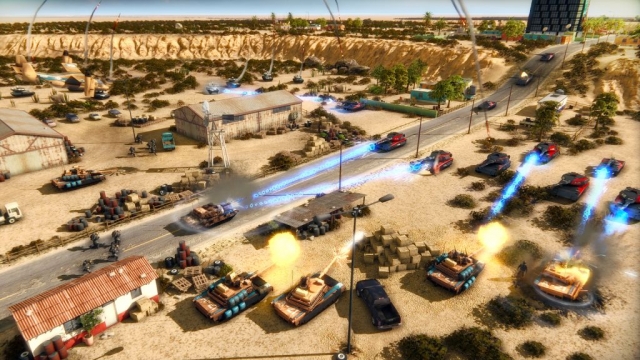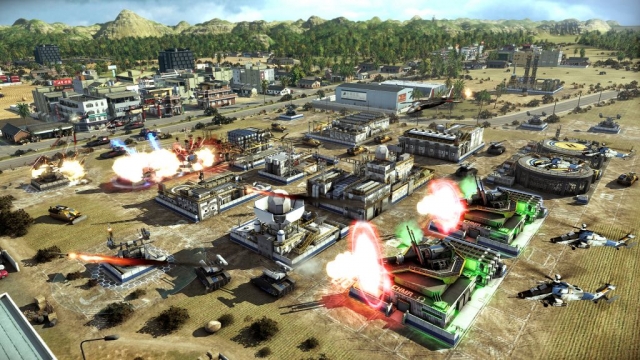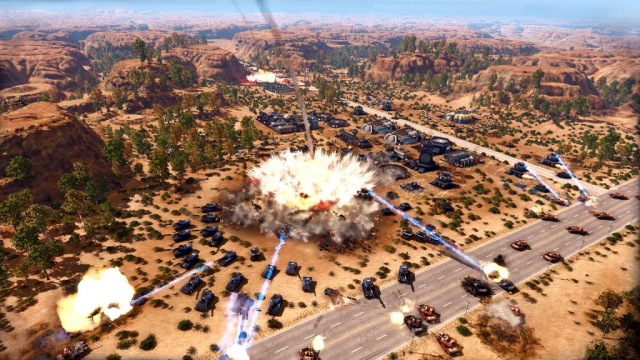Act of Aggression

The Good: Looks beautiful. Old school RTS with some cool twists. Really big maps.
The Bad: Questionable unit AI. Unnecessarily hard to get units to do what you want them to.
The Ugly: No tutorial to speak of. Terrible single player campaign. Bland factions.
With Starcraft 2 sucking all the oxygen out of the room, it kind of amazes me that RTS games continue to be made. Don’t get me wrong; I’m glad to see them. I probably play more RTS games than anything else and I almost never play Starcraft 2 – but what’s the market? What little real estate Starcraft 2 leaves behind is likely mostly claimed by Company of Heroes and there was the pretty excellent though terribly named Grey Goo earlier this year. And yet, God bless the hopeful fools, Eugen, who brought us Act of War and Ruse, two RTS games that kind of reside at different edges of the RTS envelope, goes and creates Act of Aggression, a game that offers elements of the classic RTS formula with some new elements mixed in. It’s hampered by a terrible single player campaign, almost no tutorial to speak of while having about fifty different units and variants, and believe me no one is going to mistake it for a AAA RTS title (the same couldn’t be said of Grey Goo, which felt very AAA), but the multiplayer experience is pretty solid. Think of AoA as a AA title punching a little ways above its weight class.
You can tell right away, as soon as the first cutscene starts, that this is not a AAA title. A combination of cheesy (and not good cheesy) breaking news graphics, stock footage, and high school acting class level voicework and writing tell a mangled Tom Clancy-esque story of, I’m not even sure what – terrorists and some clandestine UN security force with a breadcrumb trail littered with spies and multinational corporations. What follows is a somewhat short if otherwise typical series of missions in which you are only given a small subset of units to accomplish your goals. I realize that this is the usual way of acquainting players with the available units and tech tree and whatnot, but in this case the game introduces a unit in one mission only to take it away in the next. This creates a kind of weird puzzle-like feeling to the missions – I’ve got to solve these problems with what I have at hand – and does a terrible job of giving me a feeling for what unit is actually good for what mission. It doesn’t help matters that the in-game menus and cues tell me about things I can’t do, such as upgrade this unit with this capability, but neither the unit nor the capability are available in that mission. By the end of the single player campaign, you’ve been introduced to only some of the units and buildings, and I’m left with a million questions. Which unit can protect itself from rockets? Does it need to be upgraded to do so? What building do I find that upgrade in? Which helicopter is best for air-to-air? Air to ground? Is it even possible to repair buildings? This game needs like an encyclopedia of units. In short, the single player campaign works as neither a campaign nor a tutorial.
As I sit here writing this up, the largest problem that comes to mind is just how hard it is to do things that should be very simple to do. Click on a sniper, click on a distant target, and you could think the sniper would automatically move towards the target and then shoot it when it gets in range. What actually happens is the sniper moves all the way to the target and gets himself killed. There is a button to tell the sniper to attack-move, but that makes him move until he gets shot at before he attacks, and that probably gets him killed too. There’s a third button (and you have to figure this all out through kind of trial and error) that does what the sniper should do by default. This same headache is true of mortar teams and artillery, who seem perfectly content, despite their superior range, to stand around doing nothing until they’re attacked by much shorter range units unless you specifically tell them to attack units as they appear. That’s a level of micromanagement that just shouldn’t be necessary in this day and age. Plus there are pathing headaches, and you get the kind of herding cats problem of keeping mixed and large forces together and in a cogent formation.
The game has what I believe has become the RTS standard of three separate factions, but they’re remarkable similar. One group has its mortar carried by a two-man fire team and another has it mounted on a vehicle. One has a helicopter that shoots lasers while the other shoots rockets and bullets. That kind of thing. Everyone has a tank, some kind of APC, support units, aircraft, tiny soldiers that are mostly cheap to make and easy to kill. The economies shift around, but nothing feels distinct. While, perhaps, with a lot of play I’ll develop a favorite faction due to some tiny wrinkle I have yet to discover, there’s certainly nothing particularly alien going on – there’s no Zerg or Goo or anything – which is especially disappointing considering one of the forces is named the Chimera, which you think would bring some otherworldly coolness to the party, but such is not to be.
In what I consider a pretty bold move, the game has three collectable resources. Most come out of the ground (oil, aluminum, rare earth metals), and require you to build refineries, which then have little trucks (or aircraft, depending on your faction) that zip back and forth to your HQ (perhaps some distance away) to bring you those resources. Oil is converted into money, and you can also get money by occupying banks. Another source of cash, which as I recall is a carryover from Act of War, involves taking prisoners. Captured on the battlefield, they can be converted into quick cash, or you can build a prison (or whatever your faction calls it) and hold them for the long game, converting them into a key resource at a key moment. I liked that dynamic. In the single player campaign I found resources to be plentiful for the most part, but in skirmish the resources are much more hotly contested, which is when this game is at its best. The size of the maps can really force you to stretch your forces and supply lines. Another unique facet from Act of War that made it into AoA is that vehicles travel much more quickly by road. So do you take the long slow way around overland and avoid a possible enemy ambush/choke point set up along the roadway? Is your defense better concentrated on the road in preparation for that attack?
AoA looks very good. There’s smoke and fire and buildings collapse in on themselves when they get too much damage. Rockets fly with visible contrails and lasers sizzle through the air. The land isn’t deformable as near as I can tell, but debris builds up nicely on the battlefield. Zoom into the unit level or out to the tactical level seamlessly. Sound effects lack the kind of deep bass I would expect from the discharge of so many heavy weapons, but they suffice I suppose. Is there music in the game at all? Somehow sitting here now, I can’t recall any. I can recall the individual units saying their action lines about a million times, but every RTS since the beginning of time has that problem.
If you can muddle through the single player campaign to glean what little you can about how the game works from that, fumble your way through enough skirmish battles to figure out how all the units and buildings and stuff that is left out of the campaign works, and find someone to play with because the AI is ultimately going to win by microing in a way a human never can (I realize those are all pretty big ifs, and require a lot of work on the part of the gamer), there’s a rough gem under all the grime. It’s a throwback to C&C: Generals, which was one of my favorite RTS games of all time, but lacks the fun of that campaign and the kind of cartoonish feeling that infused that entire series so successfully. I also think (though I don’t know because I just haven’t played enough) that it suffers from some balance issues, but likely nothing that can’t be patched. Still, as a multiplayer experience, if the community manages to hold together (something incidentally that didn’t really happen with Ruse), there’s some solid big-war chaos RTS action to be had.
Reviewed By: Phil Soletsky
Publisher: Focus Home Interactive
Rating: 70%
——————————————————————————–
This review is based on a digital copy of Act of Aggression for the PC provided by Focus Home Interactive.
 Game Over Online
Game Over Online












